With the festive season fast approaching, what better time to take a look at Wine Lister’s first Champagne study, giving you the inside track on the best Champagnes that money can buy?
The in-depth report covers all angles of this fabled region, from the views of the international trade to all three Wine Lister score categories. In this blog post we drill down to focus on Champagne’s quality. Specifically, here we look at the top 20 Champagnes by Quality score:
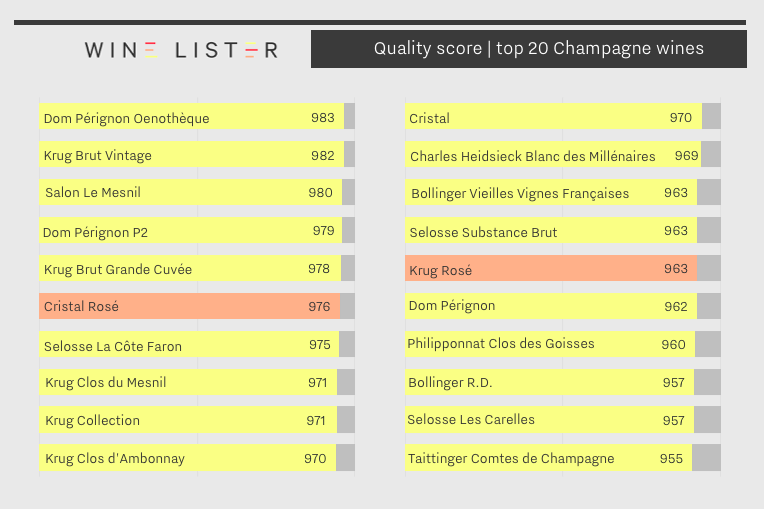
The top maison-led Champagnes dominate the top 20 Champagne Quality scores. Dom Pérignon Oenothèque tops the chart with a score of 983, and its successor (P2) comes in fourth, scoring 979. Krug manages an impressive five wines in the top 10 and six in the top 20, testament to the house’s consistently exceptional quality across its whole range. Krug Brut Vintage is second overall with a score of 982, while Krug Brut Grande Cuvée comes fifth, scoring 978. Krug Clos du Mesnil, Collection, and Clos d’Ambonnay round out the top 10 for Krug.
Salon Le Mesnil, the top scoring Champagne by overall Wine Lister score, comes third for Quality with a score of 982. Cristal Rosé is the highest scoring rosé, coming in sixth place overall with a score of 976, six points ahead of Cristal. Krug Rosé, scoring 963, is the only other rosé to make this top 20.
One of the most important trends identified in Wine Lister’s newly-released study is the rise of grower Champagnes. However, this is nascent enough that only one grower producer threatens the top Champagne houses at the top of the Quality leaderboard. That is cult grower Jacques Selosse, with three wines in the top 20, the same number as Dom Pérignon, trailing only behind Krug. The top wine from Selosse based on Quality score is La Côte Faron, coming in seventh with a score of 975. Substance and Les Carrelles also feature.
Despite the maison-led dominance of the top 20 Quality scores, grower Champagnes win the Quality crown overall. Of the 109 wines included in the study, the 29 grower Champagnes received an average Quality score of 862, while the 80 maison bottlings averaged 853, reflecting the excellent quality that grower Champagne can provide:
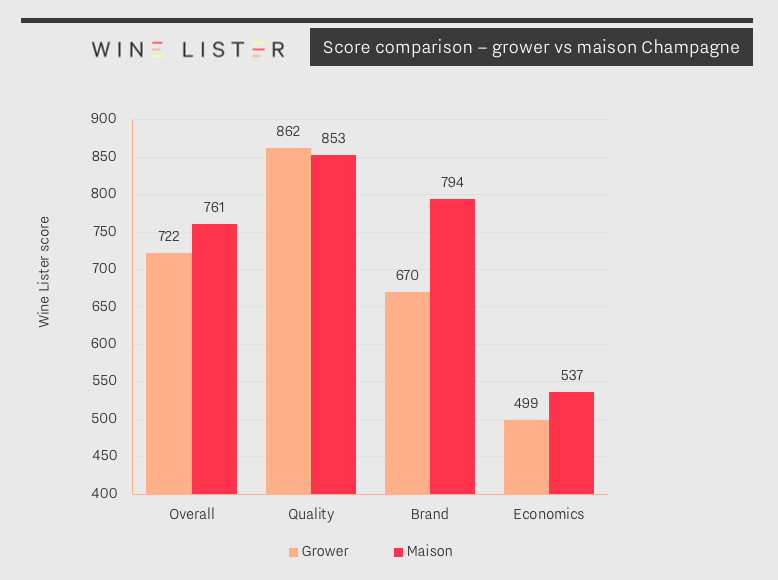
Watch this space for more on grower vs maison Champagnes, and commentary on other major trends featured in the study.
For a more in-depth look at Champagne, subscribe or log-into read the full report here. Alternatively, all readers can access a five-page executive summary. (Both versions are also available to download in French).
Other wines featured in the top 20 Champagnes by Quality score are: Charles Heidsieck Blanc de Millénaires, Bollinger Vieilles Vignes Françaises, Philipponnat Clos des Goisses, Bollinger R.D., and Taittinger Comtes de Champagne.
Our latest Listed blog focused on the top Grand Cru Champagnes by Wine Lister score. As the holiday season approaches, we look at a different kind of ‘top five’ on a sparkling theme – five of the major trends for the Champagne region, determined by a recent survey of Wine Lister’s Founding members.
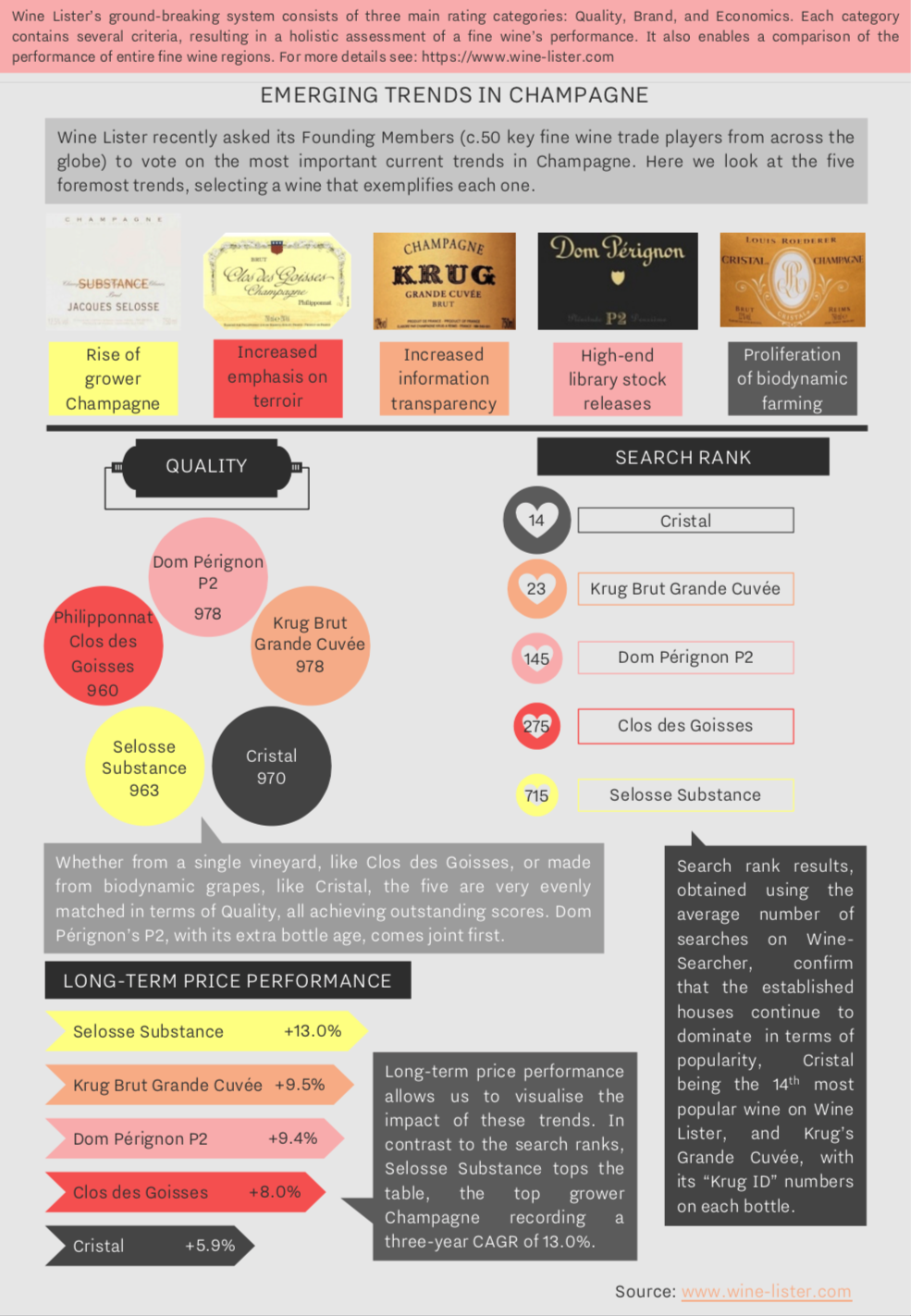
Key members of the global fine wine trade identified the rise of grower Champagnes as an emerging trend. Jacques Selosse reigns supreme, with its Blanc de Noirs La Côte Faron achieving the best Quality score of any grower Champagne on Wine Lister (975). Only an average of 1,250 bottles are produced of this each year – half of the production volume of its Substance Brut.
Founding Members also identified an increased emphasis on terroir as something to look out for. Single vineyard expressions of Champagne are well-known and already extremely sought-after, particularly Krug’s Clos du Mesnil and Clos d’Ambonnay. The latter achieves a Quality score of 970, just 10 points above Philipponnat’s Clos des Goisses, but is over 12 times the price (£1,867 vs. £147).
The phenomenon of increased information transparency is perhaps a sign that buyers are becoming more interested in Champagnes as wines, as opposed to just celebratory bubbles. Krug’s Grande Cuvée has used “Krug ID” numbers since 2011, allowing drinkers to see the vintages, vineyard plots, and grapes included in each bottle. Library releases also cater to more “wine-focused” buyers – Champagne Brand King Dom Perignon’s P2, or Bollinger R.D. are the obvious choices for this.
Finally, interest in biodynamically farmed Champagnes is on the rise, such as Louis Roederer’s Cristal, or any cuvée from Jacques Selosse.
Download a PDF of the slide above here.
First published in French in En Magnum.
Wine Lister recently looked at red Christmas drinking options with the best Bordeaux under £50, and now that the official ‘sparkling season’ is almost upon us, it is high time to consider options for holiday bubbles. Below we examine the all-round best of the best – the top five Grand Cru Champagnes by Wine Lister score.
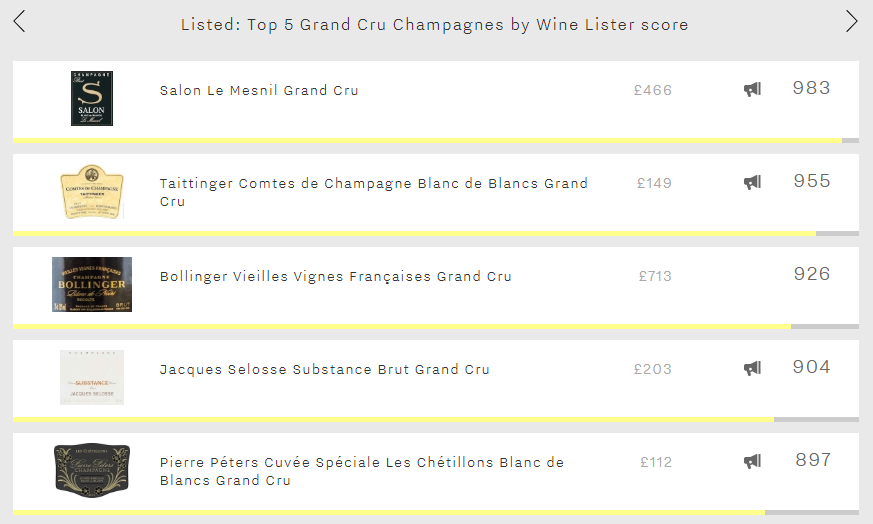
The number one Grand Cru Champagne is the indomitable Salon Le Mesnil (983). It fires on all Wine Lister cylinders, with impressive Quality, Brand, and Economics scores of 980, 989, and 981 respectively, meaning that it leads this week’s top five across each category. Moreover, it is the number one white wine on Wine Lister – still, sparkling, dry, or sweet. If you’re after a memorable bottle to kickstart the holiday season, then look no further than Salon 1996, its best ever vintage. As proof of the extraordinary longevity of top Champagne, the 1996 will be drinking well until at least 2025. Though expensive (£550 per bottle in-bond), you would be well-rewarded for paying the high price, Antonio Galloni calling the 1996 “the ultimate expression of Champagne as a wine”.
Next comes Taittinger’s Comtes de Champagne, whose main strength is its Brand score (976). This is helped by a production volume of c.170,000 bottles per annum – almost twice that of the other four Champagnes of this week’s group combined. It consequently also achieves the highest auction-trading volumes of the group, having traded 789 bottles over the past four quarters, according to our data partner, The Wine Market Journal.
In third place is Bollinger Vieilles Vignes Françaises. The term “vielles vignes” tends to get banded around quite frequently without much meaning, but in this case it carries rare significance. These old vines are planted on French rootstock, predating the spread of phylloxera which lead to the introduction of louse-resistant American rootstock onto the vast majority of France’s vines. As might be expected given the wine’s unique heritage, it comes with a hefty price tag (£713 per bottle in-bond). However, this rarity backs up its high price with an outstanding Quality score (963) – the joint-second best of this week’s top five.
In fourth place is Jacques Selosse’s Substance Brut (904). The only non-vintage wine of the five, it matches the Bollinger Vieilles Vignes Françaises’ excellent Quality score (963). Its outstanding quality, coupled with its tiny production volume of 2,700 bottles per annum, start to explain the £203 price-tag of this NV grower Champagne.
Finally, in fifth place, is Pierre Péters’ Cuvée Spéciale Les Chétillons Blanc (897). Though in fifth place, its impressive Quality (923) and Economics (922) scores suggest it could be a prime choice for cellaring. It achieves the best short and long-term price growth of this week’s top five, having added 16.7% to its price over the past six months, and recording a three-year compound annual growth rate (CAGR) of 36.5%. Any recent vintage would perhaps therefore be better placed under the Christmas tree (for an extremely lucky recipient), rather than on the Christmas table.
Thanks to tiny production quantities, exceptional quality, and increasing popularity, Burgundy tends to be expensive. In Wine Lister’s Burgundy Market Study (published in January this year), we analysed its rapidly-climbing prices. This week’s Listed blog focuses on the very tip of the Burgundy price hierarchy, with the top five by average price.
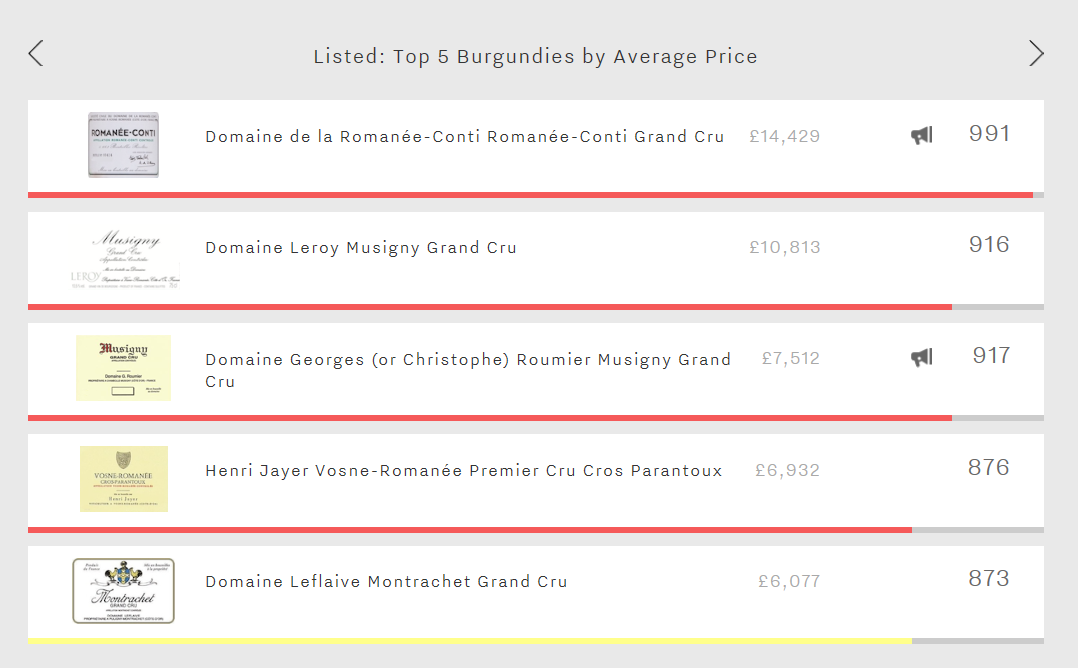
Four of this week’s top five hail from the Côte de Nuits, the first of which is, unsurprisingly, Domaine de la Romanée-Conti’s Romanée-Conti at an average price of £14,429 per bottle in-bond. The high price tag is accompanied by the best red Quality score on Wine Lister (993) and a Brand score of 989. The latter is achieved in part by being the 8th most-searched-for wine on Wine Lister (and indeed gains two and a half times as many monthly searches on Wine Searcher as the remaining wines of this week’s top five combined). Its most recent release – the 2015 vintage, receives a Quality score of 997, with Wine Lister partner critics Bettane + Desseauve and Jancis Robinson both awarding it 20/20. Even if the 2015 vintage is DRC Romanée-Conti’s best-performing in the last 15 years, its price increase of nearly 500% (from £2,925 to £17,496) since release in January is virtually incomprehensible.
In second place is one of two Musignys to feature this week. Domaine Leroy’s Musigny has an average in-bond price of £10,813 per bottle and a Quality score of 988 – just five points behind this week’s number one. Its overall Wine Lister score sits 75 points down from DRC Romanée-Conti, due to a more modest Brand score of 781. Interestingly, Leroy’s Musigny has been qualitatively more consistent over the past five releases than Wine Lister’s highest-quality red – its Quality score deviates a maximum of just one point from year to year since 2010 (compared to DRC Romanée-Conti’s maximum deviation of seven points).
Number three of this week’s top five is the second Musigny, this time from Domaine Georges Roumier. With a slightly lower price tag of £7,512 per bottle in-bond, and the second-highest Brand score of the group, Roumier is somewhat a darling of the trade – indeed, this Musigny is in the top 10% of most talked-about wines by the fine wine trade, according to Wine Lister’s Founding Member Surveys.
The last two spots are taken by wines that each stand alone among this week’s top five for their own reasons. The first, Henri Jayer’s Vosne-Romanée Cros Parantoux at £6,932 per bottle is the only Premier Cru to feature, as well as the only wine no longer in production.
Finally, Domaine Leflaive’s Montrachet Grand Cru is the only white of the group. As the most expensive white Burgundy on Wine Lister at £6,077 per bottle, it also earns white Burgundy’s highest Quality score of 985.
This week some of the Wine Lister team attended the Institute of Masters of Wine‘s Annual Claret Tasting, which this year focused on Bordeaux’s 2014 vintage. Though still young, it is a vintage that is tasting beautifully.
Throughout Wine Lister’s coverage of this year’s en primeur campaign, we found ourselves referring frequently to the 2014 vintage for comparative (and sometimes better) quality, and crucially, better prices. Below we explore the vintage in more detail, looking at Quality and Economics scores by appellation. (Note that this analysis was produced based on the basket of wines represented at the IMW Tasting).
Wine Lister’s holistic and dynamic approach allows us to not only see which appellations produced the vintage’s best wines, but also demonstrates if and how the market has since reacted to each appellation’s relative quality.
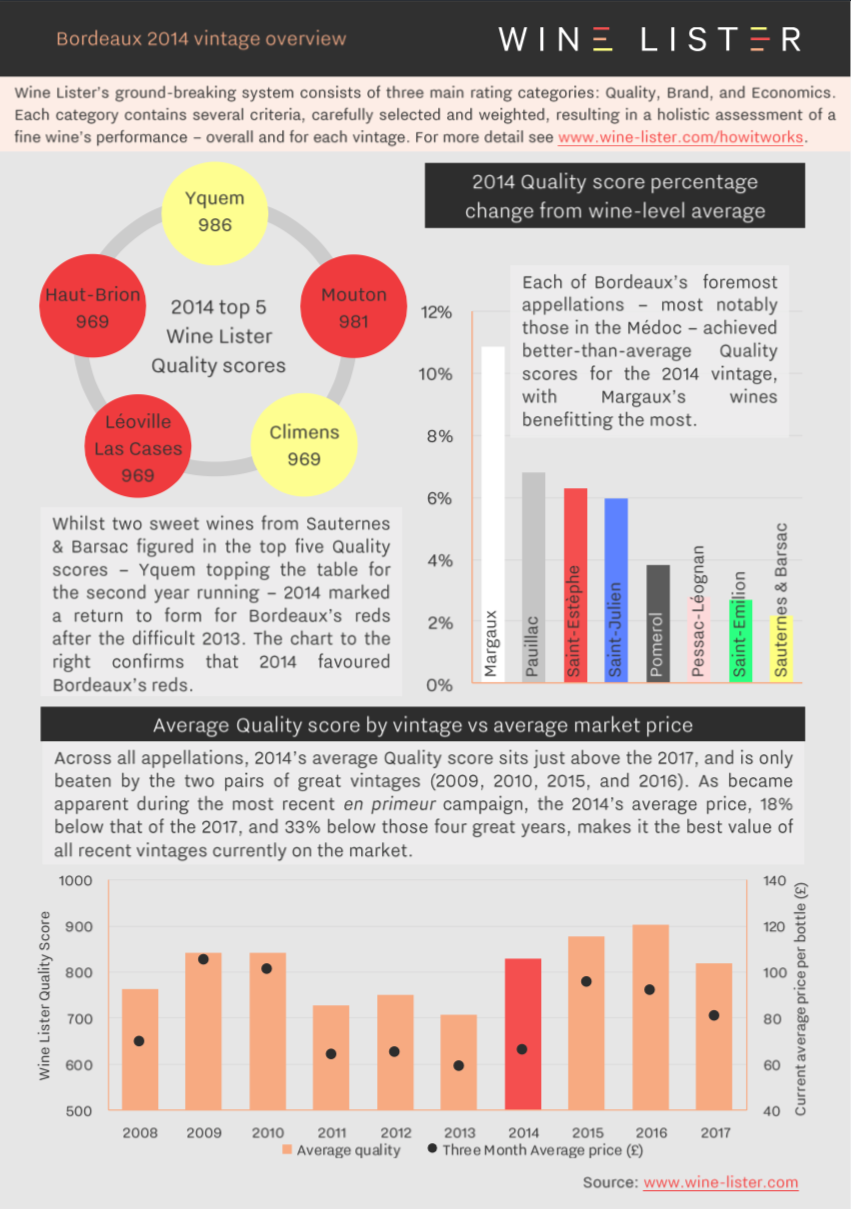
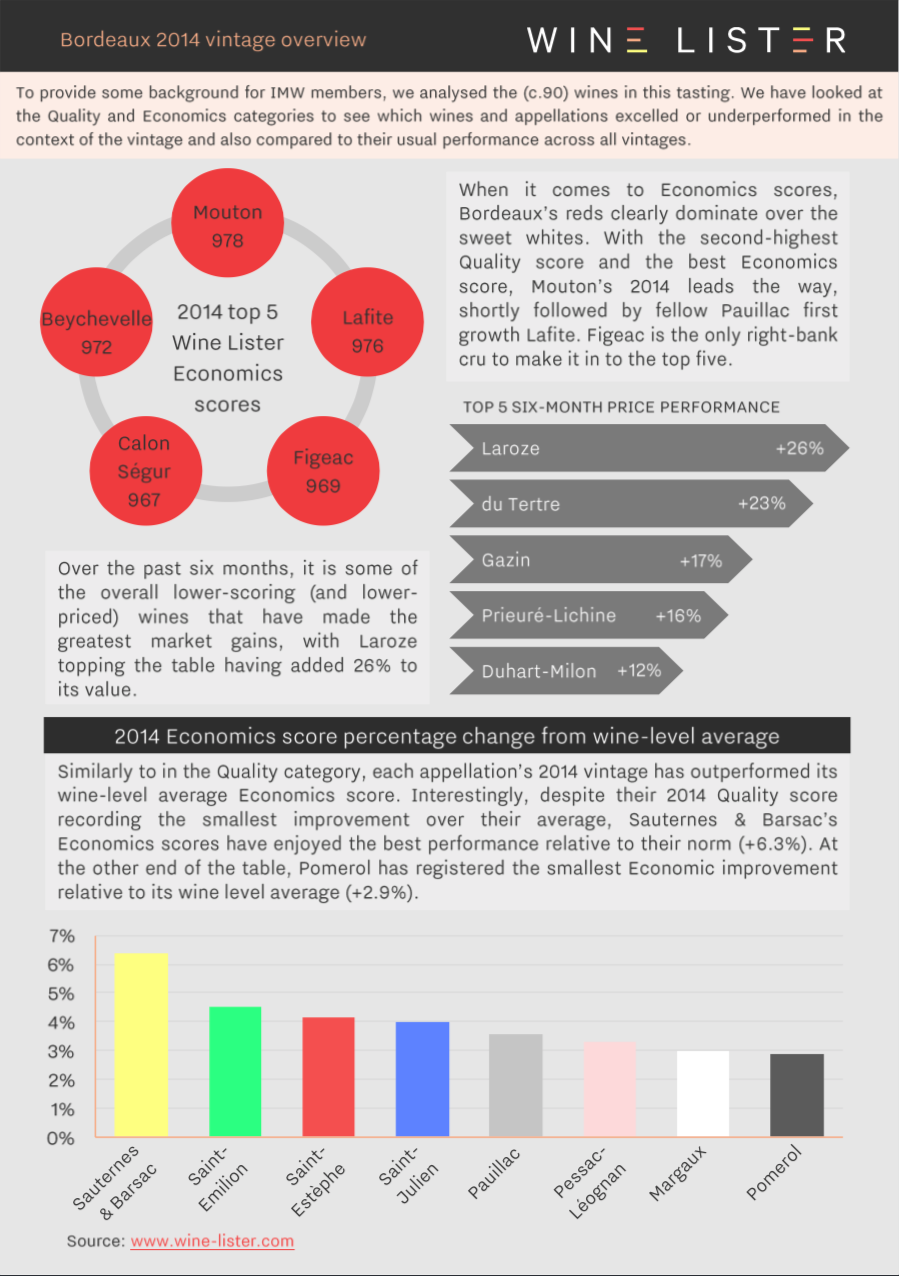
You can download the slide here: Wine Lister IMW 2014 vintage overview
Earlier this year Wine Lister compared the top 50 wines by Quality score from Old World and New. The outcome revealed a 35-point gap between the two, with an average Quality score for the 50 best New World wines of 948. This week, Wine Lister dips its toes back into New World waters to examine the top five Argentinian wines by Wine Lister score.
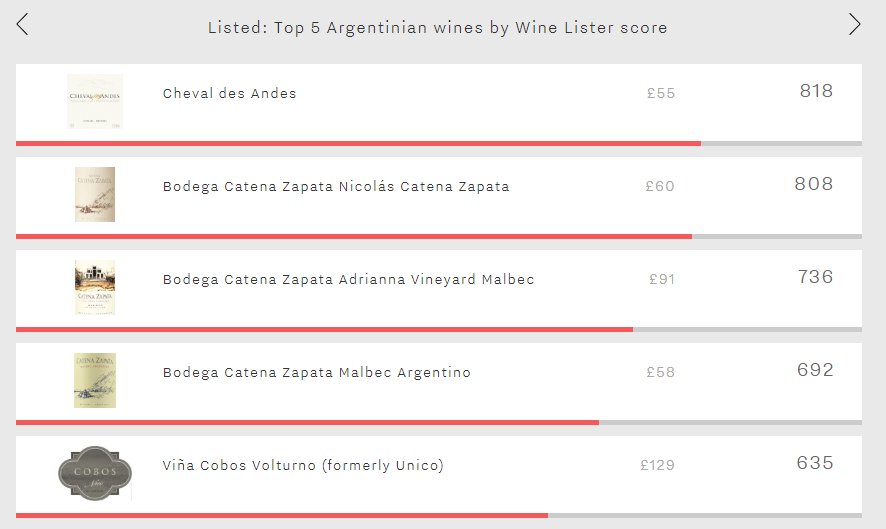
Interestingly, the winner of this week’s top five can perhaps be considered as belonging to both Worlds. Cheval des Andes, the joint venture from Terrazas de los Andes and Pierre Lurton of Cheval Blanc, has an overall Wine Lister score of 818. Unsurprisingly, Cheval des Andes shows the clear benefit of association with its Old World stablemate through a Brand score of 862, the highest of the group. This is thanks to presence in 15% of the world’s best restaurants, and a search frequency ranking as the 400th most-searched-for wine on Wine Lister’s database. It has the lowest Quality score of the five (845) – and is notably the only one of the group whose Quality score is not its strongest asset – but is also the least expensive at £55 per bottle.
Bodega Catena Zapata shows impressive presence in this week’s top five, taking the next three spots. In second place overall is Nicolás Catena Zapata with a Wine Lister score of 808. Nicolás has the highest Quality score of the group (921), however its brand strength should not be overlooked. With the second-highest Brand score of this week’s top five (828), it actually ranks 10 places higher for search frequency than New World super-brand Cheval des Andes.
Although Catena Zapata’s Adrianna Vineyard Malbec comes next for overall Wine Lister score, it is the Bodega’s Malbec Argentino (in fourth place overall) that comes next for Quality, with a score of 909. Its overall score (692) doesn’t maintain the dizzying heights set by its Quality score – nevertheless still sitting in the “strong” section of the Wine Lister 1,000-point scale – due in part to a lower Brand score (705), but mostly to a much weaker Economics score (181).
Bookending this week’s top five is another wine which might also be considered as originating from more established roots, though this time hailing from elsewhere in the New World, and more specifically, producer Paul Hobbs. Viña Cobos’ Volturno has an overall score of 635. It paints a similar picture to Catena Zapata’s Malbec Argentino, in that despite a high Quality score (902), its overall score is hindered by modest Brand and Economics scores (436 and 380 respectively).
The 2018 will be a five-star vintage for Chianti Classico wines according to Giovanni Manetti, newly-elected president of the appellation’s Consorzio. The growing season was “very regular”, with no extreme weather events, and normal picking times. Thanks to healthy grapes, ripe yet fresh, Manetti believes the vintage will be characterised by “harmony”. The DOCG appellation is set to produce c.270,000 hectolitres, back to normal production levels after a less abundant 2017.
On Monday 24th September at Fontodi, Manetti’s winery in Panzano, harvest was well underway. It had not rained for 22 days, and the ground was dusty. However, Manetti explained that in Panzano, while hot, temperatures had not risen above 36˚C, and that nights had been cool. At Castello di Fonterutoli, 15km further south, Giovanni Mazzei confirmed the heat had been nothing on 2015, when temperatures rose above 45˚C.
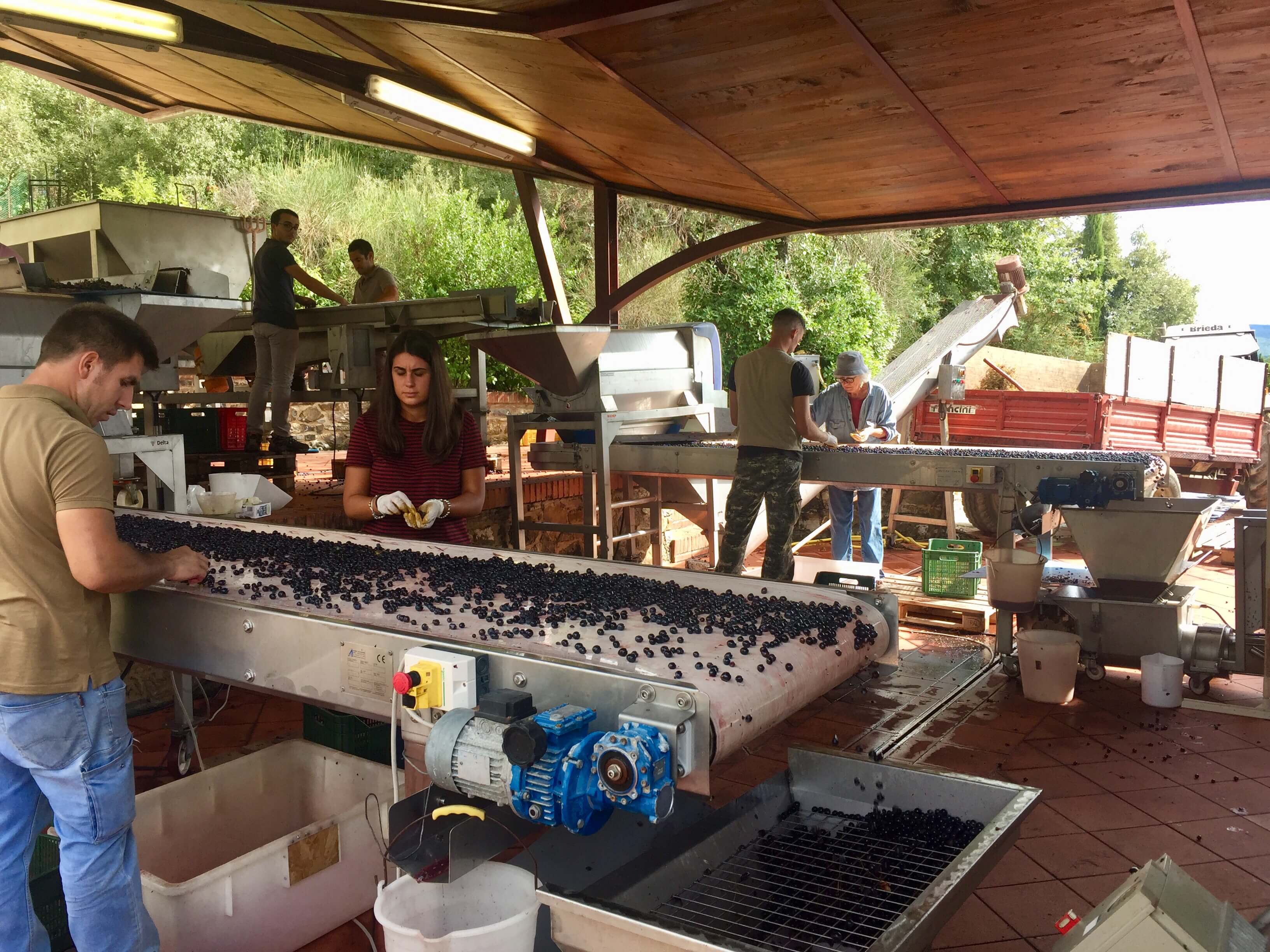
Quality control at Fontodi’s sorting tables in Chianti Classico
However, Mazzei was somewhat less sanguine about the 2018, citing humid mornings as a challenge. Having picked one third of the estate’s production by Monday, the next fortnight will be a race against rot. Mazzei predicts the vintage might fall between the opulent 2015s and the structured 2016s in terms of quality and style.
Towards the coast, in Bolgheri, the Merlot harvest is almost finished, and “the fermenting wines are silky and fragrant,” according to Axel Heinz, Estate Director at both Ornellaia and Masseto. Heinz is grateful for “excellent conditions during September with sunny and mostly dry weather, occasionally hot day temperatures but cool nights”. In Bolgheri, “mildew and humidity have been challenging,” he states, ”but we were able to bring healthy fruit to full ripeness,” recounts Heinz, who says yields in 2018 are normal. He predicts “a more delicate vintage, like 2013.”
Moving down the coast, in the Maremma, Elisabetta Geppetti, owner of Fattoria Le Pupille, spoke of regular climatic conditions leading to “a good year”. The first lot of Merlot for Geppetti’s flagship wine Saffredi is already vinified, and, she says, “marvellous”. She is delighted with her Cabernet Sauvignon too, and relayed the view of Le Pupille’s consultant oenologist Luca d’Attoma, that the grape has thrived throughout the whole southern part of Tuscany. Meanwhile Sangiovese has ripened less evenly.
Back inland, in Sangiovese’s heartland, Montalcino, the picture is less clear cut, due to excessive rain in spring and early summer. “Winemakers had not seen this kind of weather since the nineties,” explained Giacomo Pondini, Director of the Brunello di Montalcino Consorzio.
There has been “too much humidity in the air”, according to Gianfranco Soldera, with an “almost tropical” summer (a similar story to the picture recounted in our Bordeaux harvest report). At Case Basse, Soldera’s cult winery, 2018 has been “a year of suffering”, with mildew, oidium, and “mould in general”. To combat this, a team of 20 people has been combing the vineyard removing bunches non-stop since June.
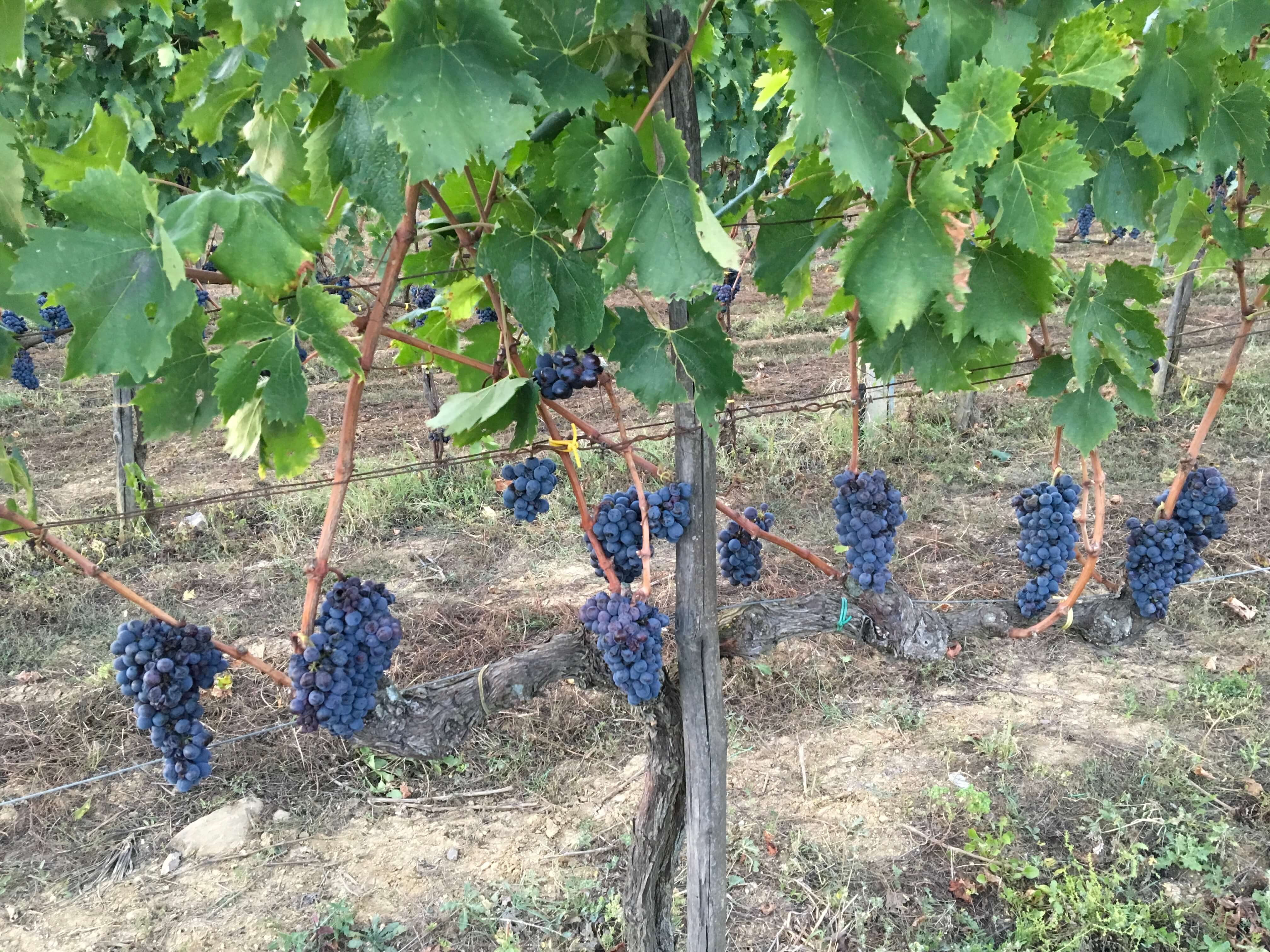
Remaining bunches after extreme selection at Soldera’s Case Basse in Montalcino
Unlike in 1989, the only year when Soldera didn’t make a wine because of too much rain, he was “ready for the challenge” this time round, and believes he will still make a great wine in 2018, albeit in very small quantities. For Soldera, rain is the enemy of vine-growing, and he rejoiced in the exceptionally dry growing season of 2017, “a year of fun”, where the vines drank mineral-rich water from the ground. Incidentally, the 2017, tasted (or rather drunk – as spitting is banned at Case Basse) from its Garbellotto cask, is incredible: alluring, alive, pure, and long.
The owner of neighbouring wineries Caparzo and Altesino, Elisabetta Gnudi puts 2018 somewhere between a four- and five-star vintage. To absorb the humidity, her team used clay dust on the vines, “like using baby powder,” she explained. Again echoing the story in Bordeaux, she reckons that “true organic vineyards haven’t harvested a single grape this year.”
At Argiano, Sales Manager Riccardo Bogi also described a less plain-sailing vintage than in Chianti. On top of the heavy rain, a hailstorm in July wiped out 25% of the crop in some vineyards. However, positioned high up on the hill of Argiano, wind in August meant the winery was able to counter rot with copper and sulphur, although the “agronomist didn’t get a vacation”, quipped Bogi. Like Heinz in Bolgheri, he expects 2018 to share characteristics with the elegant 2013s, saying they won’t have intense colour or structure.
There was a dramatic change in the weather on Monday, with temperatures dropping and strong winds picking up, which lasted throughout our three-day visit. While half of the appellation’s Sangiovese has already been harvested, and wineries are “happy with the quality,” Pondini hopes that, “the other half may benefit from this sunny, cool, windy week”.
As ripe, healthy grapes are being picked across Bordeaux, winemakers are anything but shy about the potential of the 2018 vintage. “2015 and 2016 are five-star vintages, but 2009 and 2010 are five-star plus,” said Olivier Bernard, president of the Union des Grands Crus Classés de Bordeaux. At his own property in Pessac-Léognan, Domaine de Chevalier, “2018 has 2009-2010 potential,” he declared on Wednesday morning, just as the red harvest was beginning.
Bernard is not the only Bordeaux producer daring to hope that the region has another great vintage on its way into the cellars. Part of the Wine Lister team is just back from four days in Bordeaux, where we visited châteaux on right bank and left, from Saint-Estèphe in the very north to Pessac-Léognan south of the city. We tasted lots of berries, spoke to oenologists, and even picked some grapes.
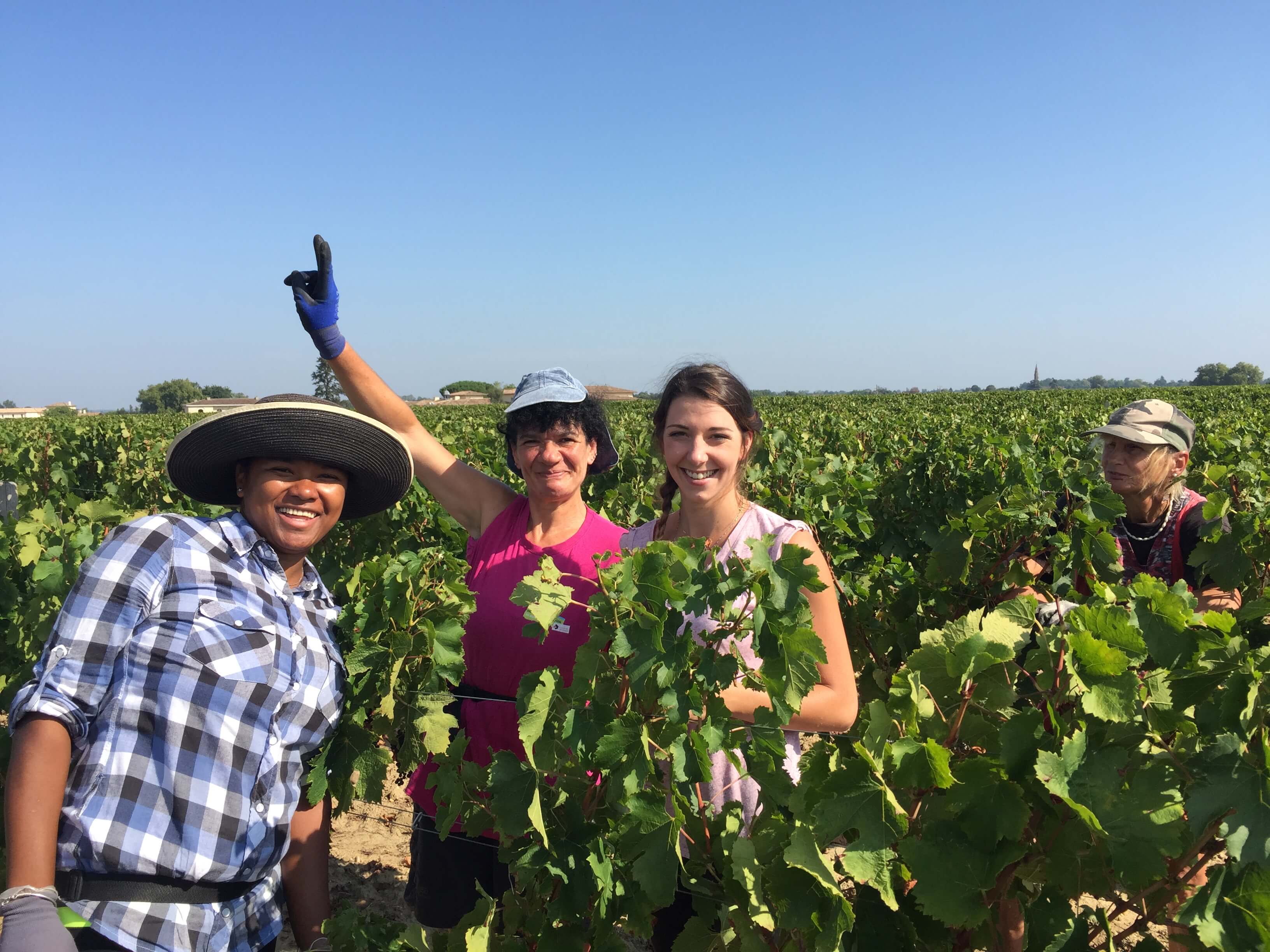
Members of the picking team at Petrus during the 2018 harvest
Producers’ smiles were big, and all the signs were promising, but after such a rollercoaster growing season, can 2018 really match up to the historic pair of 2009 and 2010? I asked straight-talking winemaking consultant Stéphane Derenoncourt if this comparison was justified. “More 2010,” he confirmed, adding, “There are going to be some delicious wines.”
Spring in Bordeaux was interminably wet, and mildew a serious threat throughout the region. “We thought there might not be a harvest at all,” recalls Nicolas Audebert, Managing Director of Châteaux Canon and Rauzan-Ségla. “It rained non-stop, and with high humidity and the high temperatures in June, it was almost tropical,” he said. Some members of Audebert’s team had never seen mildew so rife in 40 years of working the vines in Bordeaux.
Many top producers were affected, especially those practising organic or biodynamic viticulture and therefore unable to treat the vines systematically to protect from the fungus. In Saint-Estèphe, at the top of the Gironde Estuary nearest the Atlantic Ocean, Lafon-Rochet, organic since 2010 (though uncertified), abandoned the practice this year, and for good, in order to fight the rain.
However, mildew “is primarily a problem for quantity, rather than quality,” explained Axel Marchal, consultant and researcher at Bordeaux University, because the affected grapes are easily removed and discarded. “Badly hit vines can see a slight quality impact too, if the stress caused to the plant is enough to delay maturity,” he clarified.
At Canon in Saint-Emilion, quantity lost to mildew was recouped by less green harvesting later in the season. Its larger Margaux sister property, Rauzan-Ségla, was not so lucky, and yields will be lower than average. The two properties are organic (again not certified), allowing them to treat the vines when “really necessary”. However, many strictly organic or biodynamic estates will produce much smaller quantities of wine this year, meaning yields will be very varied from château to château, ranging from around 15 hl/ha to 50 hl/ha or more.
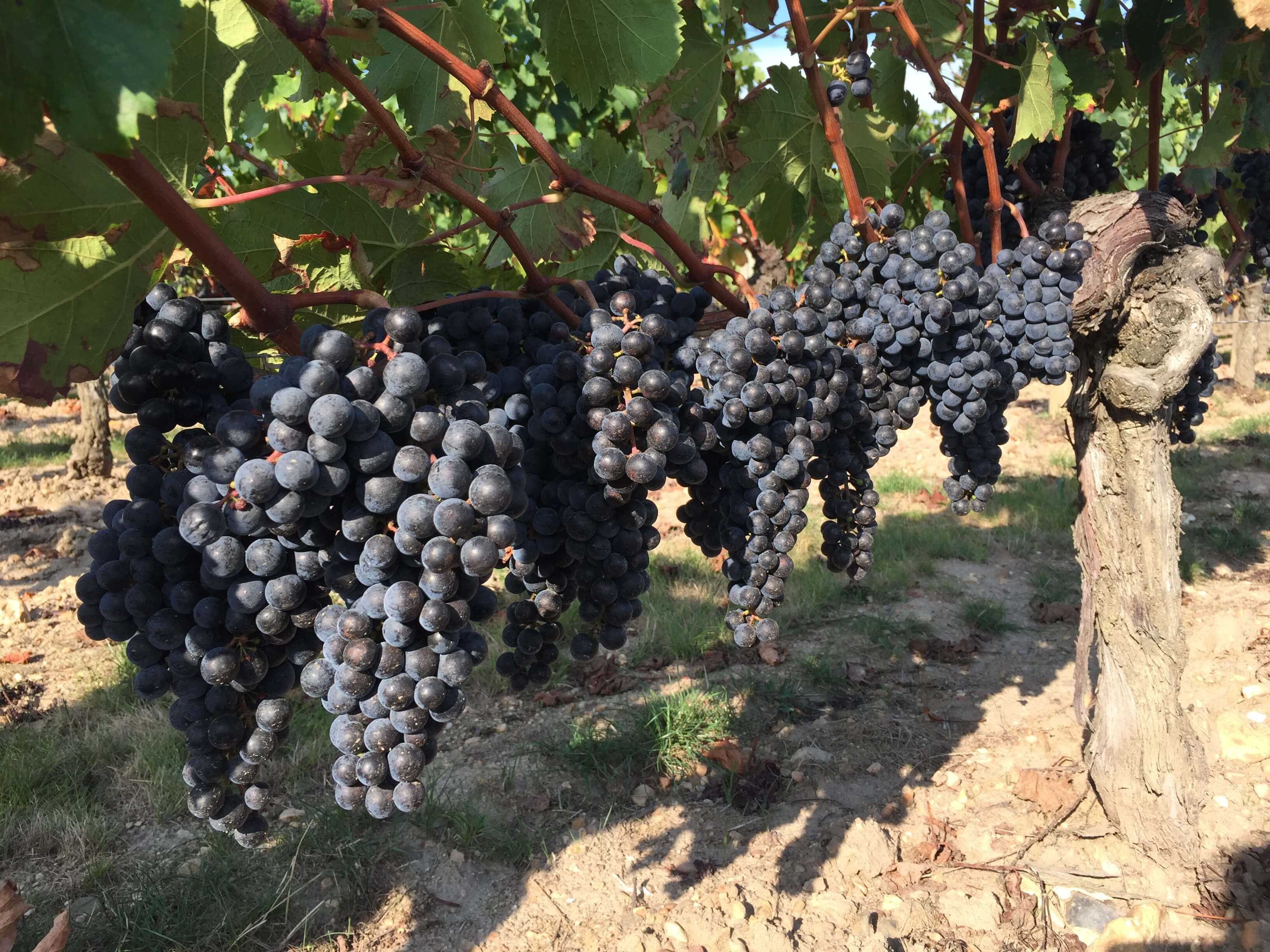
Grapes ripe for picking at Petrus
Potential quantity started off high, with the rain acting as “a signal for the plant to produce lots of fruit,” explained Bernard. The incessant spring downpours had another positive effect: they left the ground full of water, helping the vines to withstand the hot, dry summer that unfolded from 20th June onwards. “Looking at our vines, it’s hard to believe it’s been one of the driest summers in 50 years,” marvelled Bernard.
Audebert thinks the 2018 Canon will be soft and rounded, but livelier than 2005 or 2009, with phenolic potential above that of the 2010 (which of course is renowned for its intense colour and high levels of ripe tannin). When I asked if it could be as good as 2010, my question was met with silence and a roguish smile.
This week, our Listed blog focuses on Spain’s strongest Brands. Unsurprisingly, and fittingly as we creep into autumn, all are red. It will probably also come as no shock that Bodegas Vega-Sicilia features prominently – filling an impressive three out of five spots on the list, including the top two.
Wine Lister’s Brand score combines a measure of a wine’s prestige – as indicated by its visibility in the world’s top restaurants – with its level of online popularity – calculated by ranking each of the 4000+ wines in our database by monthly search frequency on the world’s most visited wine site, Wine-Searcher. Four of this week’s top five also qualify as Buzz Brands – Wine Lister’s group of wines that perform particularly well when it comes to restaurant presence and online popularity, or are demonstrating a recent growth in popularity, and which are identified by the fine wine trade as trending or especially prestigious.
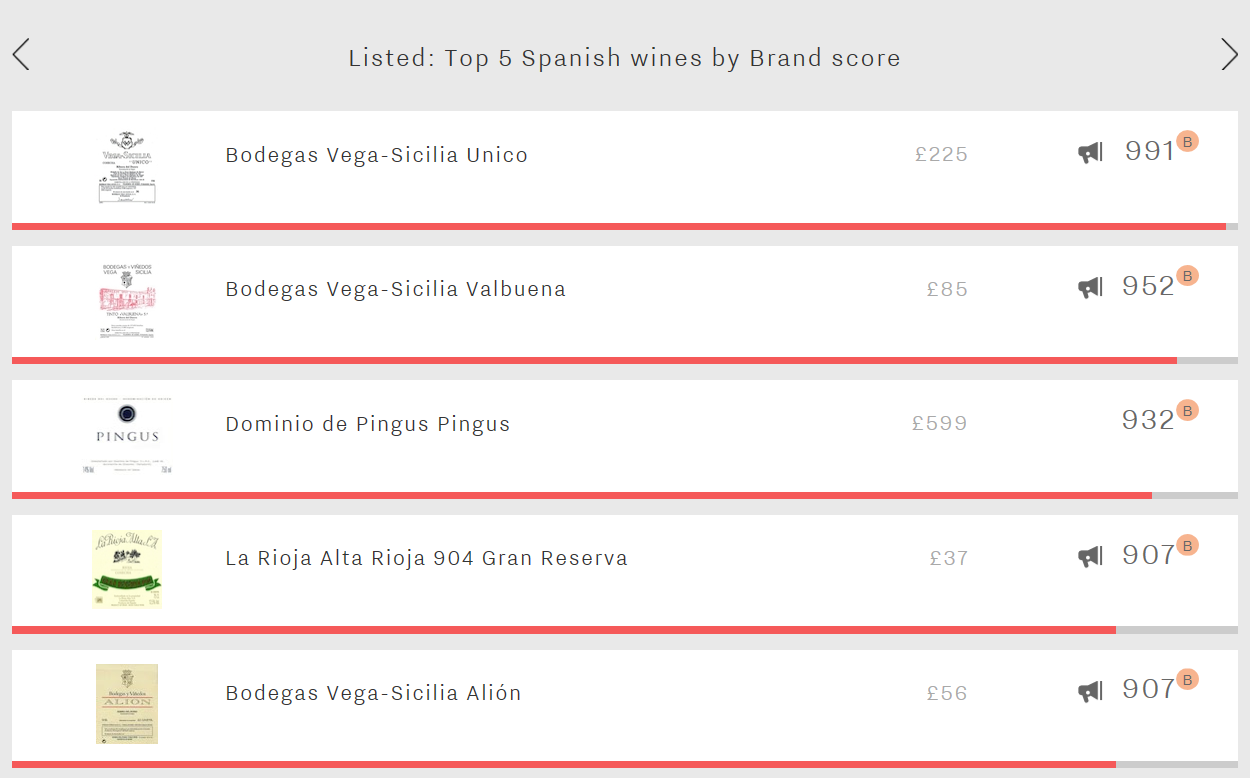
Vega-Sicilia Unico enjoys the best Brand score of any Spanish wine – and is thus the winner of this week’s race. In fact, it also achieves the highest overall Wine Lister score of all Spanish wines (974). Although Unico outperforms the rest of this week’s top five in all three of Wine Lister’s rating categories, its Brand score is particularly impressive (991). This phenomenal score is the result of excellent restaurant presence (47%) and being the 32nd most searched-for of Wine Lister’s wines on Wine Searcher.
Next, with a Brand score of 952 is Vega-Sicilia Valbuena. Despite not being able to match the Bodega’s flagship Unico in any category, it is in terms of brand recognition that it gets closest, its Quality and Economics scores trailing Unico by 115 and 54 points respectively. Its slightly lower – although still impressive – Brand score is the result of being visible in under half the number of restaurants as Unico (23%) and receiving fewer online searches (it is the 119th most popular wine on Wine Lister).
The third wine to make it onto the list is Dominio de Pingus Pingus. Presumably due to its tiny production volumes – only 6,000 bottles of it are produced each year – it is by far the most expensive of this week’s top five, at over twice the price of Unico (£599 vs £225). Its strong Brand – and high price – are supported by excellent Quality, with Pingus achieving the second highest Quality score of the group (935).
The last two places of this week’s top five are occupied by La Rioja Alta 904 Gran Reserva and Vega-Sicilia Alión. Not only do these two have identical Brand scores (907) but, despite contrasting profiles, they also share the same overall score (858). Alión achieves a higher Economics score (874 vs 729), whereas La Rioja Alta 904 records a slightly better Quality score (876 vs 812). La Rioja Alta 904 also shows that strong Brand and Quality scores do not necessarily have to mean soaring prices, as it is by far the most affordable of the five – priced at £37 per bottle on average.
It was with a heavy heart that the global fine wine trade learned of the passing of Barolo legend, Giuseppe Rinaldi, last week. Known for their elegant style and lengthy ageing potential, Rinaldi’s Barolos are not only some of the best that the region has to offer, but also some of the priciest.
In ‘Beppe’ Rinaldi’s honour, Wine Lister looks this week at the top five most expensive wines in Barolo. And there is good reason for these Barolos to be so pricey, with all of the five achieving a Quality score that falls into the “strongest” category on Wine Lister’s 1,000 point scale. On top of this, the first three qualify as Buzz Brands – Wine Lister’s group of wines that combine outstanding restaurant presence with online popularity.
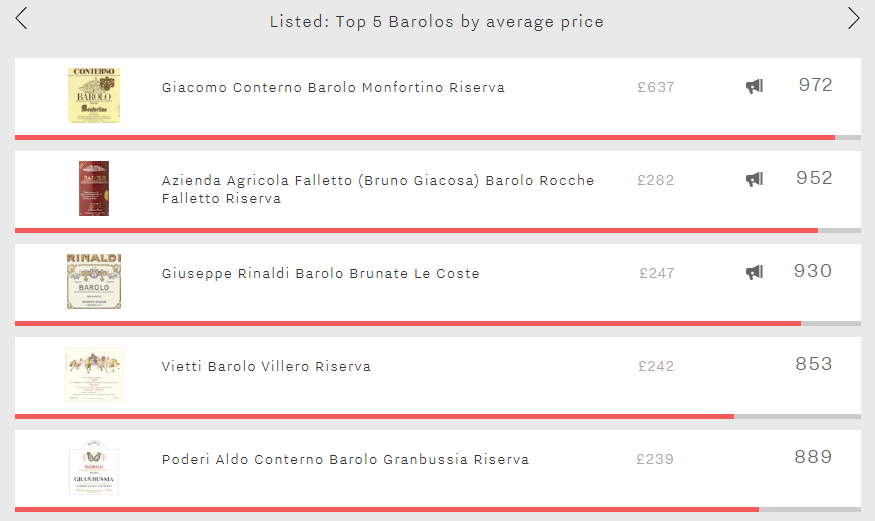
Giacomo Conterno’s Barolo Monfortino Riserva takes first place. At £637 per bottle it is more than twice the price of the rest of this week’s top five. In fact, it is the most expensive Italian wine on Wine Lister. However, it is no coincidence that Conterno’s Monfortino takes first place as it also achieves the group’s best Quality and Brand scores (977 and 969 respectively). Conterno Monfortino is actually the number one Italian wine and 11th best of all wines on Wine Lister, with an impressive overall score of 972.
This week’s second spot is occupied by Azienda Agricola Falletto (Bruno Giacosa) Barolo Rocche Falletto. Even though it competes well with Conterno Monfortino – with Quality and Brand scores of 974 and 914 respectively – it is a considerably cheaper option at £282 per bottle. In fact, despite its lower price, its Economics score is slightly superior to this week’s overall number one wine (969 vs 967), and is the group’s best. Furthermore, it is the second best of all Italian wines on Wine Lister – only beaten by Falletto’s Barbaresco Asili Riserva. The phenomenal Economics score is partly due to a three-year compound annual growth rate (CAGR) of 21.8%.
Giuseppe Rinaldi Barolo Brunate Le Coste takes third place at £247 per bottle. As perfect evidence of Rinaldi’s prowess, it is very consistent across each of Wine Lister’s three rating categories, with each score putting it amongst the very best wines in the world. Confirming its upward trajectory, it records a remarkable three-year CAGR of 36.7% – if it manages to keep that up, it will soon start to narrow the gap to Conterno’s Monfortino in this battle of the Barolos.
The two remaining wines in this group are not only very close in price but they also have the same Quality score (928). This week’s number four – at £242 per bottle – is Vietti Barolo Villero Riserva, followed closely by Poderi Aldo Conterno Barolo Granbussia Riserva at £239. Visible in 17% of the world’s top restaurants, Aldo Conterno’s Granbussia has the second-highest restaurant presence of the group. It is only beaten by this week’s number one, Conterno’s Monfortino, which is visible in 23% of top establishments.













